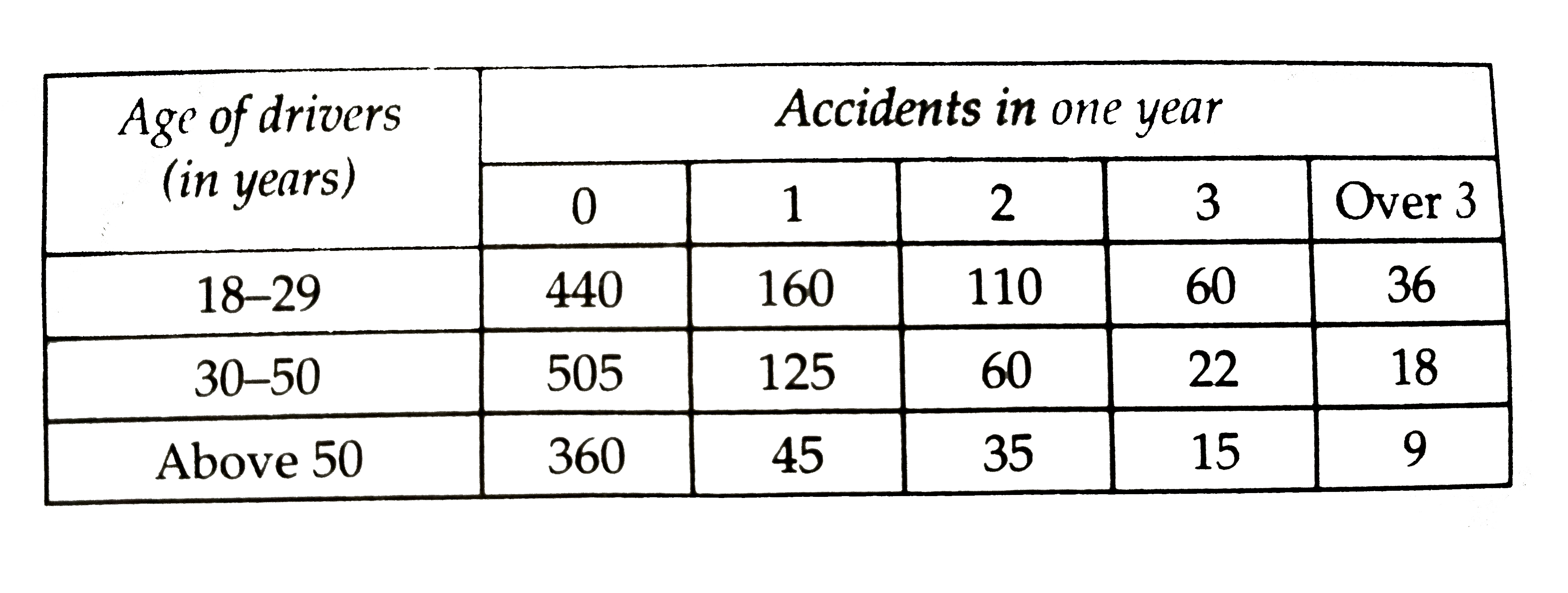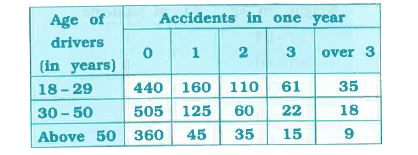An insurance company selected 2000 drivers at random (i.e., without any preference of one driver over another) in a particular city to find a relationship between age and accidents . The data obtained are given in following table :

Find the probabilities of the following events for a driver chosen at random from the city.
having no accidents in one yearSolution in Gujrati
The correct Answer is:0.653
Step by step video, text & image solution for An insurance company selected 2000 drivers at random (i.e., without any preference of one driver over another) in a particular city to find a relationship between age and accidents . The data obtained are given in following table : Find the probabilities of the following events for a driver chosen at random from the city. having no accidents in one year by Maths experts to help you in doubts & scoring excellent marks in Class 9 exams.
Topper's Solved these Questions
- BOOK - KUMAR PRAKASHANCHAPTER - PROBABILITY EXERCISE - Skill Testing Exercise8videos
PROBABILITY
- BOOK - KUMAR PRAKASHANCHAPTER - PROBABILITY EXERCISE - EXERCISE 15.123videos
PROBABILITY
- BOOK - KUMAR PRAKASHANCHAPTER - POLYNOMIALSEXERCISE - Multiple Choice Questions (MCQs)20videos
POLYNOMIALS
- BOOK - KUMAR PRAKASHANCHAPTER - QUADRILATERALSEXERCISE - MULTIPLE CHOICE QUESTION(MCQs)15videos
QUADRILATERALS
Similar Questions
An unbiased coin is tossed 20 times. In this experiment , 11 heads and 9 tails were received. Calculate the probability of receiving head and the probability of receiving tail on the basis of the experiment .
04:59View SolutionIn a cricket match a batswoman hits a boundary 6 times out of 30 balls she plays . Find the probability that she did not hit a boundary.
02:32View SolutionThe value of p(x)=x3+x2−3x−3 at x = -1 is …… .
04:25View SolutionThe ratio of four angles in order of a quadrilateral is 2:4:5: 4. Then, the measure of the smallest angle of the quadrilateral is ………..
04:43View SolutionAn insurance company selected 2000 drivers at random (i.e., without any preference of one driver over another) in a particular city to find a relationship between age and accidents. The data obtained are given in the following table:

Find the probabilities of the following events for a driver chosen at random from the city:
(i) being 18-29 years of age and having exactly 3 accidents in one year.
(ii) being 30-50 years of age and having one or more accidents in a year.
(iii) having no accidents in one year06:43View SolutionAn insurance company selected 2000 drivers at random in particular city to find a relationship between age and accidents . The data obtained are given in the following table .

Find the probability of each of the following events for a driver chosen at random from the city :
(i) being 18−29 years of age and having exactly 3 accidents in one year .
(ii) being 30−50 years of age and having one or more accidents in one year
(iii) having no accident in one year .04:47View Solutionएक बीमा कंपनी ने आयु और दुर्घटनाओं के बीच के संबंध को ज्ञात करने के लिए के विशेष नगर के 2000 ड्राइवरों का यदृच्छया चयन किया ( किसी ड्राइवर को कोई विशेष वरीयता दिए बिना ) । प्राप्त किए गए आंकड़ें नीचे सारणी में दिए गए हैं :

नगर से यदृच्छया चुने गए एक ड्राइवर के लिए निम्नलिखित घटनाओं कि प्रायिकताएँ ज्ञात कीजिए :
(i ) 18-29 वर्ष की आयु का जिसके साथ एक वर्ष में ठीक - ठीक 3 दुर्घटनाएँ घटी हैं ।
( ii) 30-50 वर्ष कि आयु का जिसके साथ एक वर्ष में एक या अधिक दुर्घटनाएँ घटी हैं ।
(iii ) जिसके साथ एक वर्ष में कोई दुर्घटना नहीं घटी ।05:35View Solutionएक बीमा कंपनी ने आयु और दुर्घटनाओं के बीच के संबंध को ज्ञात करने के लिए एक विशेष नगर के 2000 ड्राइवरों का यदृच्छया चयन किया (किसी ड्राइवर को कोई विशेष वरीयता दिय बिना)। कुछ किए गए आँकड़े नीचे सारणी में दिय गए है :

नगर से यादृच्छया चुने गए एक ड्राइवर के लिए निम्नलिखित घटनाओं की प्रायिकताएँ ज्ञात कीजिए:
(i) 18 - 29 वर्ष की आयु का जिसके साथ एक वर्ष में ठीक-ठीक 3 दुर्घटनाएँ घटी है।
(ii) 30 - 50 वर्ष की आयु का जिसके साथ एक वर्ष में एक या अधिक दुर्घटनाएँ घटी है।
(iii) जिसके साथ एक वर्ष में कोई दुर्घटना नहीं घटी है।03:34View SolutionAn insurance company selected 2000 drivers at random (i.e., without any preference of one driver over another) in a particular city to find a relationship between age and accidents. The data obtained is given in the following table: Find the probabilities of the following events for a driver chosen at random from the city: (i) The driver being in the age group 18-29 years and having exactly 3 accidents in one year. (ii) The driver being in the age group of 30-50 years and having one or more accidents in a year. (iii) Having no accidents in the year.
04:13View SolutionAn insurance company selected 2000 drivers at random (i.e., without any preference of one driver over another) in a particular city to find a relationship between age and accidents. The data obtained is given in the following table: Find the probabilities of the following events for a driver chosen at random from the city: (i) The driver being in the age group 18-29 years and having exactly 3 accidents in one year. (ii) The driver being in the age group of 30-50 years and having one or more accidents in a year. (iii) Having no accidents in the year.
03:27View SolutionAn insurance company selected 2000 drivers at random (i.e., without any preference of one driver over another) in a particular city to find a relationship between age and accidents. The data obtained is given in the following table:

Find the probabilities of the following events for a driver chosen at random from the city:
(i) The driver being in the age group 18-29 years and having exactly 3 accidents in one year.
(ii) The driver being in the age group of 30-50 years and having one or more accidents in a year.
(iii) Having no accidents in the year.01:59View SolutionAn insurance company selected 2000 drivers at random (i.e., without any preference of one driver over another) in a particular city to find a relationship between age and accidents. The data obtained is given in the following table:

Find the probabilities of the following events for a driver chosen at random from the city:
(i) The driver being in the age group 18-29 years and having exactly 3 accidents in one year.
(ii) The driver being in the age group of 30-50 years and having one or more accidents in a year.
(iii) Having no accidents in the year.03:05View SolutionAn insurance company selected 2000 drivers at random (i.e., without any preference of one driver over another) in a particular city to find a relationship between age and accidents. The data obtained are given in the following table:A g e\ o
02:33View SolutionAn insurance company selected 2000 drivers at random (i.e., without any preference of one driver over another) in a particular city to find a relationship between age and accidents. The data obtained are given in the following table: Find the probabilities of the following events for a driver chosen at random from the city: (i) The driver being in the age group 18−29 years and having exactly 3 accidents in one year. (ii) The driver being in the age group of 30−50 year and having one or more accidents in a year. (iii) The number of drivers having no accidents in one year
03:39View SolutionAn insurance company selected 2000 drivers at random (i.e., without any preference of one driver over another) in a particular city to find a relationship between age and accidents . The data obtained are given in following table :

Find the probabilities of the following events for a driver chosen at random from the city.
being 18-29 years of age and having exactly 3 accidents in one year.04:18View Solution

